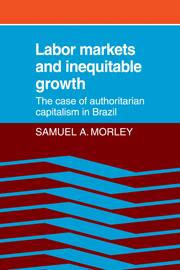Book contents
- Frontmatter
- Contents
- List of tables and figures
- Preface
- Part I Growth, employment creation, and inequality in Brazil
- Part II The effect of supply and demand on labor markets during rapid economic growth
- 6 Migration and the modernization of the agricultural labor force
- 7 The absorption of migrants into the urban economy
- 8 Trends and theories of the wage differential during economic growth
- 9 The market for skilled labor
- 10 Agriculture, wage policy, and the wages of unskilled labor
- 11 Additional perspectives on inequitable growth in Brazil
- 12 Conclusions
- Data appendix
- Bibliography
- Index
6 - Migration and the modernization of the agricultural labor force
Published online by Cambridge University Press: 07 October 2011
- Frontmatter
- Contents
- List of tables and figures
- Preface
- Part I Growth, employment creation, and inequality in Brazil
- Part II The effect of supply and demand on labor markets during rapid economic growth
- 6 Migration and the modernization of the agricultural labor force
- 7 The absorption of migrants into the urban economy
- 8 Trends and theories of the wage differential during economic growth
- 9 The market for skilled labor
- 10 Agriculture, wage policy, and the wages of unskilled labor
- 11 Additional perspectives on inequitable growth in Brazil
- 12 Conclusions
- Data appendix
- Bibliography
- Index
Summary
One of the key processes transforming the traditional dual economy into a modern industrial one is the transfer of agricultural labor to the modern sector. This process has been going on in Brazil for many years, the proportion of the Brazilian labor force working in agriculture having fallen from 64% in 1940 to 44% in 1970. Exactly how this important sectoral and geographic transfer of human resources occurred and how the untrained rural labor force was absorbed into the modern urban economy is not well understood. In this chapter we examine the migration process, and in the following chapters we look at the way in which the urban markets absorbed those migrants.
Economists view labor's move out of agriculture as a rational response to expected income differentials. Harris and Todaro (1970) and Todaro (1969) provided the basic model of the process. Agricultural workers migrate to the city when the income that they expect to earn there exceeds what they can earn in the agricultural sector. Expected income in the city is the minimum wage multiplied by the probability of finding an urban job. If all workers are alike, that probability should be one minus the rate of unemployment in the city. Basically the process is seen as one in which agricultural workers come to the city and join the unemployment pool while they wait for scarce urban jobs. Unemployment is a sort of job queue.
Subsequent research suggests that the Harris–Todaro model is not too appropriate for Latin America. First, open unemployment is not as high as would be suggested by urban–rural wage differentials.
- Type
- Chapter
- Information
- Labor Markets and Inequitable GrowthThe Case of Authoritarian Capitalism in Brazil, pp. 113 - 140Publisher: Cambridge University PressPrint publication year: 1983



